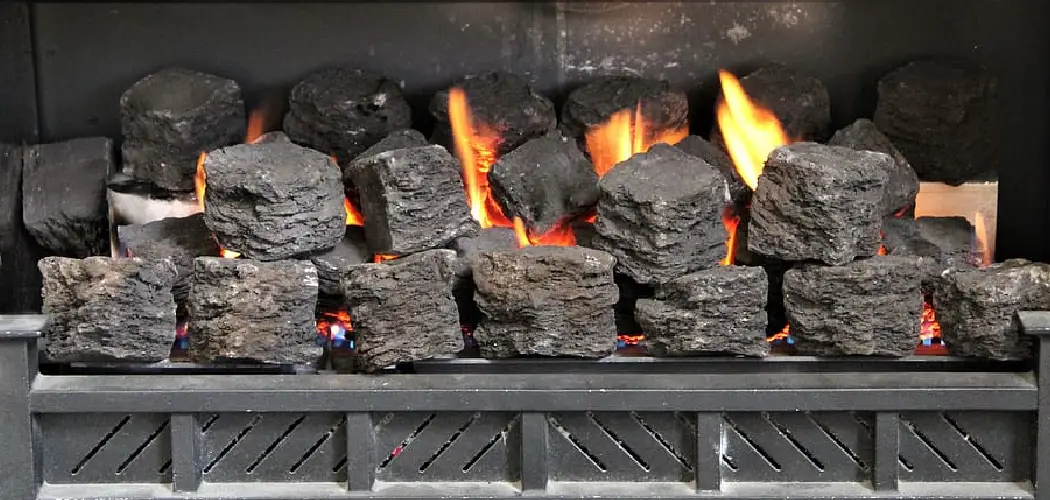Welcome to our comprehensive guide on “How to Place Lava Rocks in a Gas Fireplace.” A gas fireplace adds warmth and ambiance to your home, and to top it off with a more realistic and natural appearance, nothing beats the use of lava rocks.
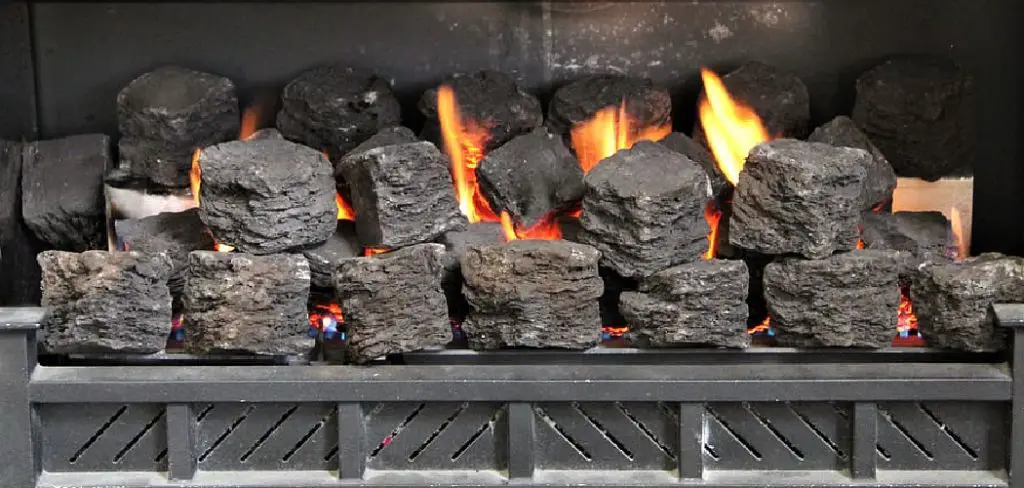
But how should you place them for the best effect? With our step-by-step tutorial, you can make your gas fireplace not only a source of warmth but also a visually appealing centerpiece in your living space. So why not enhance your fireplace experience by learning how to place lava rocks in your gas fireplace correctly? Let’s dive in!
Understanding Lava Rocks
What are Lava Rocks?
Lava rocks are naturally occurring volcanic rocks formed from solidified molten lava. Characterized by their porous nature and rugged appearance, these rocks are known for their excellent heat resistance and thermal conductivity properties.
Types of Lava Rocks for Gas Fireplaces
While there are many types of lava rocks, the ones used in gas fireplaces are typically of two types: small-sized rocks and large-sized rocks. Small-sized lava rocks are commonly used to fill the fire pit to a certain level while the larger-sized rocks are placed on top to create an aesthetically pleasing arrangement.
Benefits of Using Lava Rocks in Gas Fireplaces
Lava rocks offer numerous benefits when used in gas fireplaces. In addition to their aesthetic appeal, they are excellent at retaining and radiating heat, making your fireplace more efficient. Their porous nature also helps to evenly distribute the gas evenly, providing a more uniform and realistic fire. Furthermore, lava rocks are highly durable and require less maintenance, which can extend the lifespan of your gas fireplace.
Step-by-step Instructions for How to Place Lava Rocks in Gas Fireplace
Step 1: Inspect Your Gas Fireplace
Ensure that all safety mechanisms are working correctly. Ensure the gas line is not damaged and there are no loose connections or combustible materials in the vicinity of the unit. Carefully remove the old lava rocks from your gas fireplace using a pair of gloves or an oven mitt. Be sure to discard the old rocks in a safe area.
Step 2: Clean The Firebox
Once all of the old lava rocks are removed, use a vacuum to clean out any debris from the firebox. Make sure all dirt and dust particles are removed for optimal efficiency. If any of the gas logs or valves are broken, replace them. This is a crucial step in ensuring your fireplace works properly.
Step 3: Place Lava Rocks
Once all safety measures and repairs have been taken care of, begin to place lava rocks in the firebox. Make sure each rock is placed evenly apart, and fill up the bottom of the firebox with the rocks. Make sure there is enough air circulation in the firebox for optimal combustion. If not, then adjust the vents accordingly.
Step 4: Check Gas Pressure
After placing all lava rocks in the firebox, make sure to check and adjust your gas pressure. This will help regulate the amount of heat generated by the fireplace. Before lighting your gas fireplace, ensure all connections are properly secured and sealed off to avoid dangerous leaks or explosions.
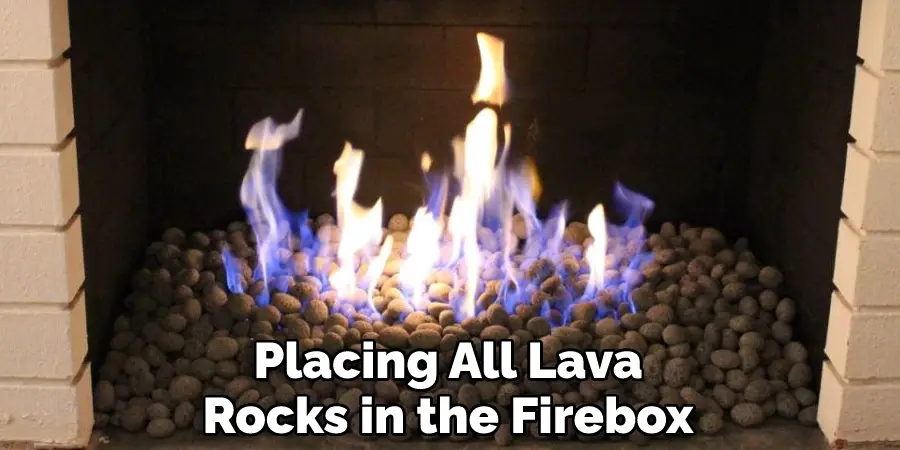
Step 5: Test the Fireplace for Leaks
After connecting everything, light up the fireplace and wait for a few minutes. Carefully check for any gas or flame leaks during this time. Once you have confirmed that all safety measures have been taken and the fireplace is working properly, enjoy your newly updated gas fireplace with lava rocks.
Following these steps will ensure your gas fireplace is both safe and efficient.
Safety Tips for How to Place Lava Rocks in Gas Fireplace
- Ensure the gas fireplace is completely off and has had time to cool before beginning to place lava rocks.
- Check that all of the lava rocks are similar in size to create an even layer on the bottom of your fireplace.
- Wear protective gloves and safety glasses when handling the lava rocks during installation.
- Place the lava rocks in an even layer inside your gas fireplace and avoid blocking any of the openings or vents.
- Keep a fire extinguisher nearby when placing the lava rocks to ensure safety in case any flames occur during installation.
- Avoid touching the metal parts of the fireplace with bare hands, as it could be very hot from previous use.
- Do not place anything besides lava rocks in the gas fireplace, as this could create a fire hazard.
- Test the gas fireplace after installation and ensure proper airflow is achieved before using it again.
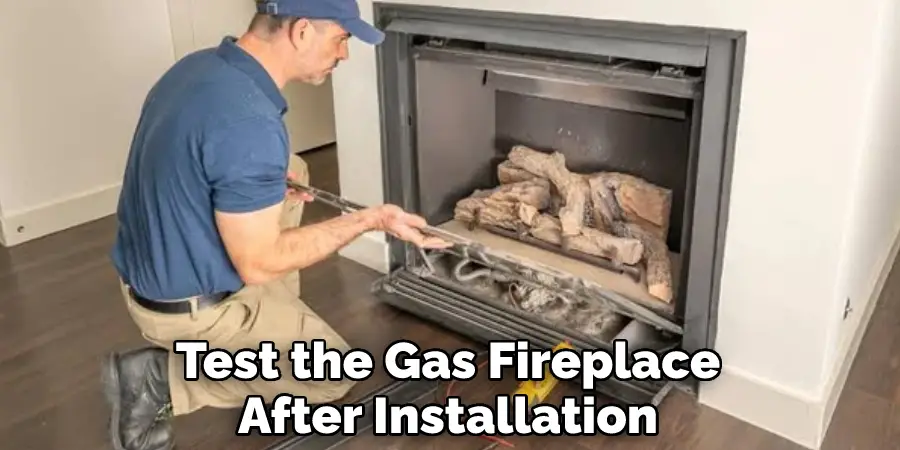
Following these safety tips will help you ensure that your gas fireplace with lava rocks is installed safely and correctly. The proper installation lets you enjoy a warm and cozy fire without any worries.
Common Issues to Look Out For When Installing Lava Rocks in a Gas Fireplace
Issue 1:
The rocks are not evenly distributed throughout the firebox. This can cause hot spots in certain parts of the fireplace, leading to possible damage to its components.
Solution:
To avoid this issue, make sure that all of the lava rocks are evenly distributed around the firebox before inserting into the fireplace. Additionally, layer them in multiple levels if needed to ensure maximum evenness.
Issue 2:
The wrong type of lava rocks is used in the fireplace. Different types of lava rocks can produce varying amounts of flame or heat, which could potentially cause damage to the gas fireplace components.
Solution:
Make sure that you purchase the precise type and size of lava rocks for your gas fireplace model. Additionally, contact a professional gas technician if you have any questions about which material is best for your model.
Issue 3:
The lava rocks are not placed on top of the noncombustible material before being inserted into the fireplace.
Solution:
In order to ensure maximum heat absorption and optimal aesthetic results, it is recommended that you use a noncombustible material such as sand or brick chips underneath the lava rocks. Doing this will help prevent any heat from being lost and ensure that your gas fireplace looks great for many years to come.
Issue 4:
The mesh screen or grate is not installed over the lava rocks.
Solution:
To prevent sparks from flying out of the fireplace, it is important to install a mesh screen or grate over the top of the lava rocks. Doing so will help keep you and your home safe and secure while using your gas fireplace.
By following these tips, your lava rock installation process should be quick and easy while ensuring the safety and efficiency of your gas fireplace. With the right preparation and knowledge, you can have peace of mind that your fireplace is safe and secure for use. Additionally, regular maintenance and replacement of the lava rocks will help ensure their longevity in your gas fireplace while helping to keep you warm all winter long.
Where Can I Purchase Quality Lava Rocks For My Gas Fireplace?
When purchasing lava rocks for your gas fireplace, it is important to choose a quality material that will last for many years. Many hardware stores and online retailers specialize in selling lava rocks for gas fireplaces, with some even offering custom-made pieces that are tailored to the specific needs of your fireplace.
When shopping for lava rocks, be sure to look for products that are certified safe for use in gas fireplaces so that you can be sure of their quality and safety. Additionally, make sure to purchase the correct size and shape for your model of the gas fireplace, as this will impact how effectively the rocks heat up and disperse flames in the firebox. With a bit of research, you should have no problem finding quality lava rocks for your gas fireplace that are both safe and effective.
Maintenance and Cleaning of Lava Rocks in a Gas Fireplace
Regular Inspection of Lava Rocks
Regular inspection of lava rocks in your gas fireplace is crucial for maintaining their optimal efficiency and safety. Check for any signs of damage, such as chips or breaks in the rocks. Examine the rocks for dirt buildup or clogging, as these can interfere with the heat distribution and overall functionality of your fireplace. Additionally, verify that the lava rocks are evenly distributed across the firebox to ensure balanced heat output.
Cleaning Tips to Maintain Their Appearance and Functionality
To maintain the appearance and functionality of your lava rocks, cleaning is an essential routine. Start by turning off your fireplace and allowing the lava rocks to cool completely. Then, remove the rocks and gently brush off any loose debris with a soft brush. For a more thorough cleaning, you can wash the rocks with warm water and a mild detergent. Rinely rinse them thoroughly to remove any soap residue and let them dry completely before placing them back in the fireplace. Regular cleaning will not only keep your lava rocks looking attractive but also ensure they function effectively.
Replacing Lava Rocks When Necessary
Over time, lava rocks can become too dirty or damaged for cleaning to be effective. In this case, they should be replaced. As a general guideline, consider replacing your lava rocks every two to three years to ensure your gas fireplace operates efficiently and safely. When replacing the rocks, be sure to purchase the correct size for your fireplace, and remember to wear protective gloves and eye protection while handling the old rocks. Regular replacement of lava rocks will keep your gas fireplace looking great and working properly for years to come.
Benefits of Adding Decorative Items to Your Gas Fireplace With Lava Rocks
Benefit 1: Enhanced Visual Appeal
Adding decorative items such as lava rocks to your gas fireplace can give it a unique look and create an inviting atmosphere in the home. The visual effect of the flame reflecting off of the rocks will make the fire appear more vibrant and captivating. Additionally, if you opt for other decorative items like fire glass or ceramic logs, they can provide an interesting and eye-catching element to the room.
Benefit 2: Improved Heat Distribution
When adding decorative elements like lava rocks, fire glass, or ceramic logs to your gas fireplace, they can help evenly distribute heat throughout the space. This is especially important if you’re looking to keep certain areas of the room warm and comfortable. With a well-distributed flame pattern, the entire area can be more evenly heated and feel comfortable all around.
Benefit 3: Reduced Odors and Fumes
One of the most important benefits of incorporating decorative items into your gas fireplace is a reduction in odors and fumes. As the gases pass through these lava rocks or other materials, it will help reduce any overwhelming odor that may come from burning fuel in the fireplace. This will make for a more enjoyable experience when enjoying your gas fireplace.
Benefit 4: Increased Safety
The last benefit of adding decorative items to your gas fireplace is increased safety. Using lava rocks or other materials can help reduce the chances of hot spots in the firebox, as well as block sparks and embers that may fly out of the fireplace. This will help keep you and those around you safe while enjoying the warmth of your gas fireplace.
Benefit 5: Easier Cleanup
Finally, with the addition of decorative elements like lava rocks, you’ll have an easier time cleaning up after use. Since the firebox is filled with these materials, they can help absorb some of the debris that comes out when a fire is lit. This will make for quick and easy cleanup after each use of your gas fireplace.
Ultimately, adding decorative elements like lava rocks to your gas fireplace can have a variety of benefits, from improved heat distribution and increased safety to enhanced visual appeal. With the right maintenance and upkeep, you’ll be able to enjoy these benefits for years to come.
Are There Any Special Techniques to Consider When Placing the Rocks?
When placing the rocks into your gas fireplace, there are a few key techniques to keep in mind. First and foremost, make sure that you place the lava rocks onto a flat surface before inserting it into the fireplace. This will help ensure that all of the rocks fit securely in their designated space. Additionally, when packing the lava rocks into your fireplace, make sure to do so in layers. This will allow the lava rocks to be evenly spread out and ensure they don’t move around during use.
Lastly, for optimal results, it is recommended that you use a noncombustible material such as sand or brick chips underneath the lava rocks. Doing this will help absorb the heat produced by the burning gas and enhance the overall appearance of your gas fireplace. With these simple techniques in mind, you can easily and safely place lava rocks into a gas fireplace. Doing so will not only add to the visual appeal of your home but also give you peace of mind that your fireplace is safe and secure for use.
Are There Any Maintenance Tips for Lava Rocks in a Gas Fireplace?
When you have the lava rocks in place, they will need regular maintenance to ensure their maximum effectiveness in your gas fireplace. Here are some tips:
- Occasionally check and clean the rocks to ensure they are not damaged or clogged with debris. This can be done by using a soft brush or vacuum cleaner hose attachment to remove any excess dirt and debris.
- Ensure the rocks are positioned correctly in the fireplace for maximum heat efficiency. This means that they should be spaced evenly around the firebox, not clustered up near one side or the other.
- Use a mesh screen or grate over the top of the lava rocks to prevent sparks from flying out of the fireplace.
- If you have any doubts or questions about how to position the lava rocks, contact a professional gas technician for assistance.
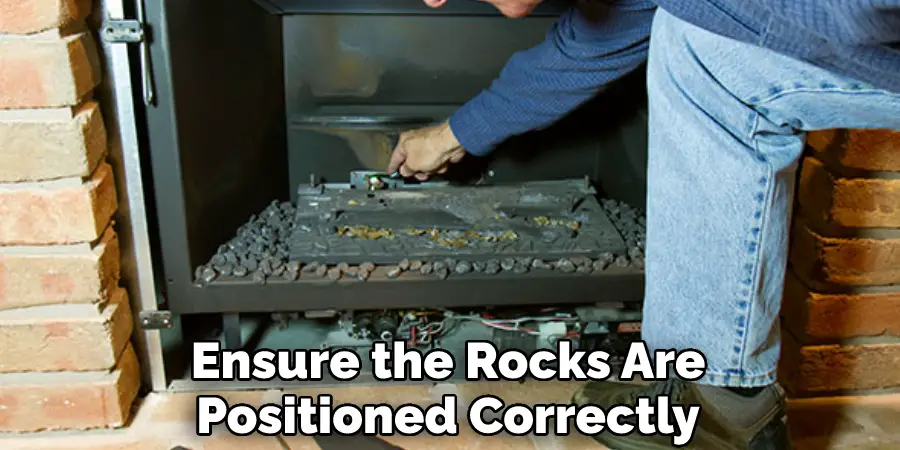
By following these simple maintenance tips, your lava rocks should last for many years in your gas fireplace and help keep you warm all winter long.
How Often Should You Replace the Lava Rocks in Your Gas Fireplace?
When placed correctly, lava rocks in a gas fireplace can provide an attractive and flame-enhancing layer to the firebox. However, after time, these rocks will become dirty and need replacing. To ensure that your gas fireplace is operating at its best, you should replace the lava rocks every two to three years. Replacing your lava rocks regularly is important for safely and properly operating your gas fireplace. Over time, dust and dirt will accumulate in the firebox and on the surface of the rocks, leading to possible blockages or reduction in flame size.
Additionally, regular replacement ensures that no residual gases build up inside the firebox from when you light your fireplace. When replacing your lava rocks, be sure to purchase the correct size and shape for your fireplace. The wrong type of rocks may produce excess flame or cause hot spots in the firebox that may damage components of the gas fireplace. Additionally, when removing old lava rocks, be sure to wear protective gloves and eye protection, as small pieces can fly out when disturbing the rocks.
Are There Any Other Items You Should Consider Adding to the Gas Fireplace in Addition to Lava Rocks?
In addition to lava rocks, you may want to consider adding other items that can help enhance the look and feel of your gas fireplace. These include:
- Fire Glass or Fire Beads: These are colorful and reflective and create a vibrant aesthetic when heated from the gas burner.
- Ceramic Logs: If you’re looking to add a more traditional look, ceramic logs can bring a pleasant aesthetic to your gas fireplace.
- Fire Stones: Like fire glass, these small stones provide an elegant visual effect when the flame is lit and make for a great addition to any gas fireplace.
No matter which option you choose, adding decorative elements like lava rocks or other materials can help make your gas fireplace more inviting and aesthetically pleasing.
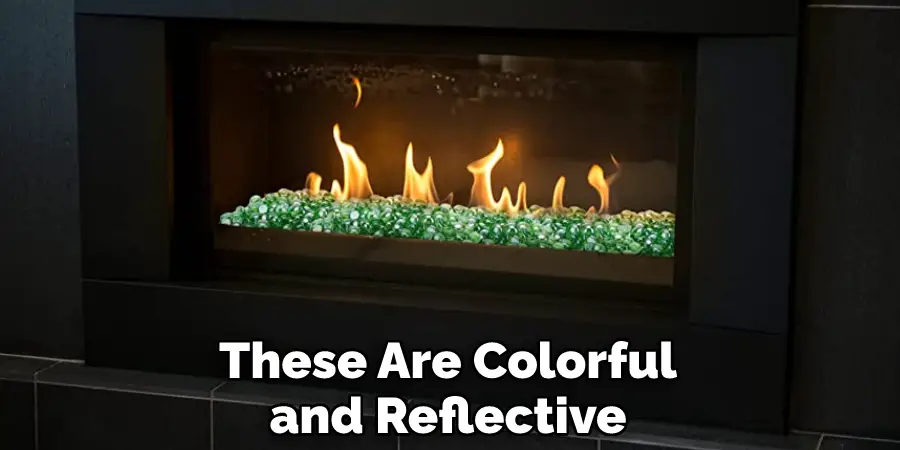
Conclusion
In conclusion, placing lava rocks in a gas fireplace can be a great way to spruce up the look of your home and add a unique element of warmth. While it may seem daunting at first, following these steps will ensure that you get the most out of this project. Start by measuring the dimensions of your fireplace and buying enough lava rock to cover the base. After that, spread the lava rock evenly across the base and cover it with a layer of fire-resistant material.
Finally, shape the rocks to create a more appealing look, and enjoy the warmth and visual appeal of your new gas fireplace. I hope this article has been beneficial for learning how to place lava rocks in a gas fireplace. Make Sure the precautionary measures are followed chronologically.

